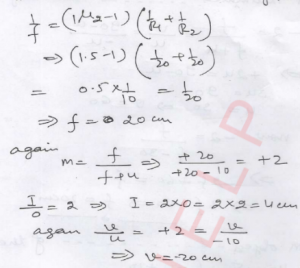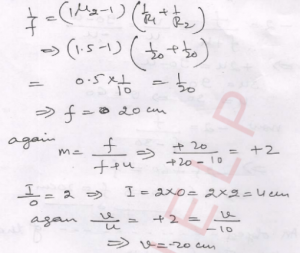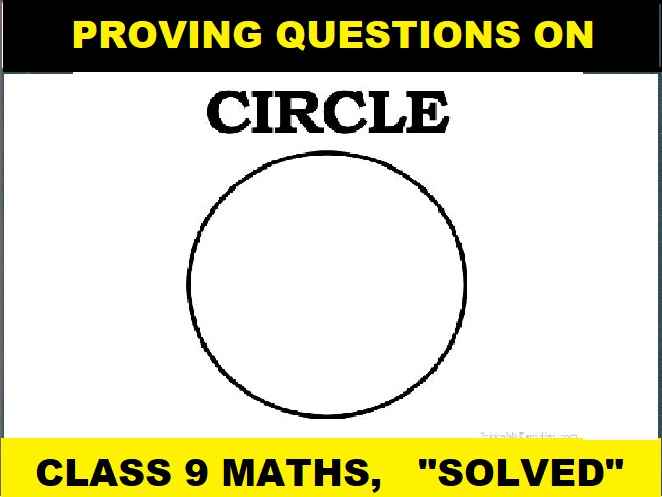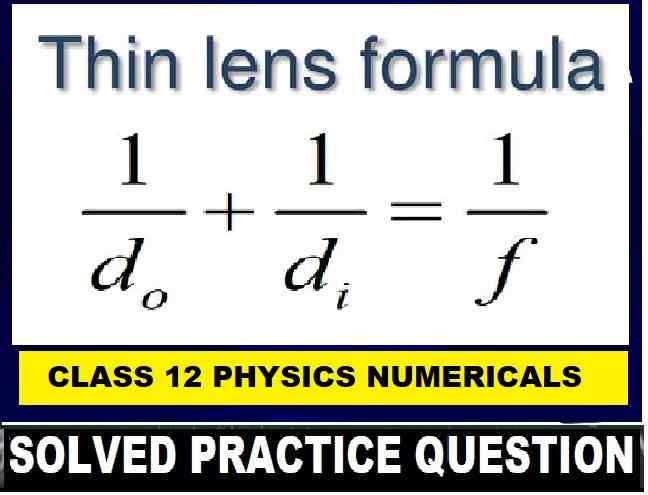Magnification by the Lens Numerical Class-12 Nootan ISC Physics Solution Ch-16 Refraction of Light at Spherical Surfaces : Lenses. Step by step solutions of Kumar and Mittal Physics of Nageen Prakashan as council latest prescribe guideline for upcoming exam. Visit official Website CISCE for detail information about ISC Board Class-12 Physics.

Magnification by the Lens Numerical Class-12 Nootan ISC Physics Solution Ch-16 Refraction of Light at Spherical Surfaces : Lenses
| Board | ISC |
| Class | 12 |
| Subject | Physics |
| Book | Nootan |
| Chapter-16 | Refraction of Light at Spherical Surfaces : Lenses |
| Topics | Numericals on Magnification by the Lens |
| Academic Session | 2025-2026 |
Numericals on Magnification by the Lens
Class-12 Nootan ISC Physics Solution Ch-16 Refraction of Light at Spherical Surfaces : Lenses
Que-30. An illuminated object and a screen are 90 cm apart. Find the nature and focal length of a lens required to produce a clear image on the screen, twice the size of the object.
Ans- -2 = f/f+u = v/u = 90-u/-u
=> 2u = 90 – u
=> 3u = 90
=> u = 60
now -2 = f/f-30
=> -2f + 60 = f
=> f = 20 cm (convex)
Que-31. An object is placed at a distance of 5 cm from a convex lens of focal length 10 cm. Find the position and magnification of the image.
Ans- u = -5 , f = +10
m = f/f+u = 10/10-5 = v/-5
=> v = -10 cm
and m = +2
Que-32. What can you tell about the image of a 3 cm long object placed at a distance of 15 cm from a lens, if the magnification is known to be – 2?
Ans- m = -v/u = -2 = -v/15
=> v = 30 cm
Que-33. The diameter of the sun is 1.4 × 10^9 m. Find the diameter of the image of the sun formed by a convex lens of focal length 1.0 m. The distance of the sun from the earth is 1.0 x 10^11 m.
Ans- m = v/u = Dia of image / Dia of the object
=> 1 / 1 x 10^-11 = Dia of image / 1.4 x 10^9
=> Diameter of the image = 1.4 x 10^-2 m = 1.4 cm
Que-34. A double convex lens of glass (n = 1.5) has radii of curvature, each 20 cm. An object 2 cm high is placed at 10 cm from the lens. Find the position, size and nature of the image.
Ans-

Que-35. A double concave lens of glass (n = 1.5) has both radii of curvature of magnitude 40 cm. An object 2 cm high is placed at 10 cm from the lens. Find the position, size and nature of the image.
Ans-

Que-36. An object 10 cm high is placed at the principal focus o a concave lens of focal length 20 cm. Find the position size and nature of the image.
Ans- m = f/f+u = -20/-20-20 = 1/2
I = mo = 1/2 x 10 = 5 cm (virtual)
Que-37. A lens produces a virtual image of size 2/3 that of the object placed at 20 cm from the lens. Find the position of the image, nature and focal length of the lens.
Ans- m = v/u = 2/3
v = 2u/3 = 2 (-20)/3 = -40/3 cm
f = uv/u-v = -20 x -40/3 / -20 + 40/3
=> f = -40 cm
Que-38. A lens of focal length 12 cm produces a virtual image of size 1/3 that of the object. Find the nature of the lens and the positions of the object and the image.
Ans- m = f/f-u = v/u
=> 1/3 = f/f-u = v/u
=> v = u/3 = -24/3 = -8 cm
only concave lens makes diminished virtual image
∴ f = -12
1/3 = -12/-12+u
=> -36 = -12 + u
=> u = -24 cm
Que-39. A convex lens of focal length 12 cm produces an image on a screen three times in size than the object. What is the distance of the object from the lens?
Ans- m = v/u => v = 3u
1/f = 1/v – 1/u
=> 1/12 = 1/3u + 1/u
=> u = 12 x 4/3 = 16 cm
Que-40. A convex lens forms 19 times magnified image of an object on a screen placed 10 m from the lens. What is the focal length of the lens?
Ans- m = v/u = 19
=> v = 19 u = 10 => u = 10/19
1/f = 1/19u + 1/u
=> 1/f = 20/10
=> f = 0.5 cm
Que-41. A 10 cm long pin lies along the principal axis of a convex lens of focal length 10 cm such that the nearer end of the pin is at a distance of 15 cm from the lens. Find the length of the image of the pin formed by the lens.
Ans-

Que-42. An object is placed in front of a convex lens at such a distance that its real image of the same size is formed. When the object is displaced 16 cm towards the lens, still a real image is formed but now its size is 3 times the size of the object. Calculate the focal length of the lens.
Ans- v/2f-16 = 3
=> v = 3(2f-16)
1/f = 1/v-1/u
=> 1/f = 1/3(2f-16) + 1/(2f-16)
=> f = 24 cm
Que-43. A convex lens of focal length 10 cm produces images of the same magnification 2 when an object is kept at two distances x₁ and x2 (x1 > x2) from the lens. Find the ratio of x1 and x2.
Ans- v = 2×1
1/10 = 1/2×1 + 1/x1
=> x1 = 15 cm
1/10 = 1/2×2 – 1/x2
=> x2 = 5 cm
x1/x2 = 15/5 = 3/1 = 3:1
Que-44. A concave lens forms the image of an object such that the distance between the object and its image is 15 cm and the magnification produced is 1/2 length of concave lens?
Ans- 15 = -u+v
m = v/u
=> 1/2 = v/u => u = 2v
After substituting the value we get
v = -15 cm and u = -30 cm
now, 1/f = 1/v-1/u
=> 1/f = 1/-15 – 1/-30
=> f = -30 cm
— : End of Magnification by the Lens Numerical Class-12 Nootan ISC Physics Solution Ch-16 . :–
Return to : – Nootan Solutions for ISC Class-12 Physics
Thanks
Please share with your friends


